Bulldog or Lapdog?
If you want a companion who will languorously keep you company through those lazy Sundays afternoons, after a heavy meal, absorbing the quiet solitude of the atmosphere, happy with being scratched behind the ears every now and then, then the gentle-natured Bulldog is the perfect pet for you.
This may fool many an onlooker into assuming that the Bulldogs are a lazy breed. But your Bulldog can be extremely active when he feels motivated enough. In spite of the many generations of breeding, some part of their ancestors sporty natures remains in the gene pool. Just watch some YouTube videos of Bulldogs Skateboarding or similar Bulldog Sports! That’ll disabuse your ‘The Bulldog is a lazy breed’ notions real quick!

CC photo credit: arlo j Lazy English Bulldog |
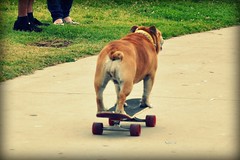
CC photo credit: vmiramontes Active English Bulldog |
|---|
The typical purebred Bulldog is characterized by its stocky build, shortened muzzle, shuffling gait, a disproportionately large head, and extremely strong, undershot jaws. Thanks to all the Caricatures and Cartoons with shark-like teeth bared in fury, the Bulldog has been grossly misrepresented! In spite of the ferocious-looking face, all that your sweet Bulldog really wants is to be thoroughly cuddled and babied. Even the smallest Bulldog breeds are not nearly small enough to be considered lapdogs. But that doesn’t stop your pudgy little darling from wanting to be one!
The Family Dog!
The Bulldog is a true family dog. Bulldogs are happiest when they are surrounded by their human families. This is not a breed that likes to be left alone for long periods of time. They are extremely affectionate, to the point that they will happy slobber all over you and drench you in you in their drool in an extravagant demonstration of love, even time you step back into the room!
But you will see the all his placid demeanor and tender temperament go flying out of the window should he so much as imagines a threat to his human family. Essentially being fighting breeds, the Bulldogs of today make excellent guard dogs. They are the epitome of courage and fearlessness in the face of danger.
The Bulldog has a slightly muffled bark, which doesn’t make him a great “Alarm” dog. Besides, he is likely to attack first and bark later, should an uninvited intruder dare to enter the premises.
Another reason why Bulldogs make great pets for city-dwelling dog lovers is because they do not require a lot of care. Grooming and caring for your bulldog is an effortless task. And they don’t require a lot of exercise in the open.
 Though, if you are a careless pet owner, then the Bulldog is not for you. It is imperative for bulldog owners to keep a watchful eye on their dogs and vet visits must be conscientious and like clockwork. Since the Bulldog is genetically prone to certain health problems, any likely Bulldog owner must be aware of these health issues and their associated risks.
Though, if you are a careless pet owner, then the Bulldog is not for you. It is imperative for bulldog owners to keep a watchful eye on their dogs and vet visits must be conscientious and like clockwork. Since the Bulldog is genetically prone to certain health problems, any likely Bulldog owner must be aware of these health issues and their associated risks.
But it is important mention here that with appropriate grooming and care, a good diet and proper training, a caring Bulldog owner can get by for years and years without his darling pet suffering from even a single ailment!
Bulldog History
The Bulldog is said to have originally descended from the Asiatic Mastiff. They are claimed to have originated in the British Isles. Hence the English Bulldog is considered to be the primary Bulldog breed.
The Bulldogs of the yester years were primarily bred for their fighting skills. They were used by immigrants and travelers to guard against wild animals, poachers and thieves. Later, during the middle ages, once their aggressive fighting skills became more well-known, they are used for driving cattle into slaughterhouses and from keeping intruders at bay.
In the 1800s, when bull baiting was a very popular sport, bulldogs were used to fight wild bulls in the fighting arena. Being quite the gruesome sport, this made it necessary for the original bulldog to be ferocious, fearless and almost insensitive to pain, in order to survive. While bull baiting and dog fighting was finally declared illegal, the name “Bull” stuck and the breed consequently came to be known by the name “Bulldog”.
After the abolition of the gory sport of bull-baiting, Bulldog breeders started working towards creating a more evolved breed. The fierce characteristics of the fighting dogs had to be subdued on order to preserve the breed and make it more adapted to family life. Several generations of careful and selective breeding has helped create the mild-mannered, superior specimen of today.
Apart from the English Bulldog, there are several other popular Bulldog breeds such as the French Bulldog, the Bull Mastiff, the American Bulldog and the Aussie Bulldog. Bulldogs come in all shapes and sizes. So you can take home the sweet little French Bulldog (also called the Toy Bulldog) to the (equally sweet!) giant-sized American Bulldog.
In the end, it won’t matter what shape, size and color your Bulldog is. He will enamor you with his playful, forever-a-puppy-at-heart nature and his docile, easygoing tolerance. Treat you Bulldog with the right mixture of unconditional love and gentle discipline, and he will give it back manifold with his loyal reverence.
|
Olde English Bulldogge |
|
|---|---|
|
American Bulldog
|


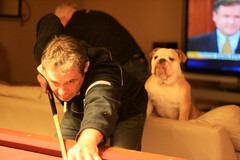
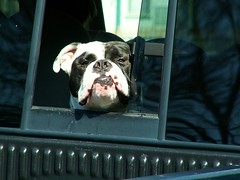
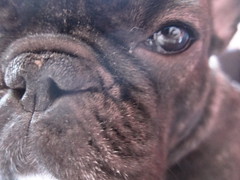

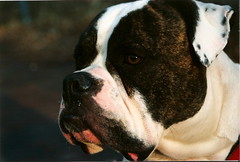
Hello. I have websites related to the dog trainer/training and was
wondering what are the requirements to get listed on your links page on http://www.bulldogmixes.com.
Please let me know if you are interested in exchanging links.
Thanks for your time.
Best Regards,
Jennifer